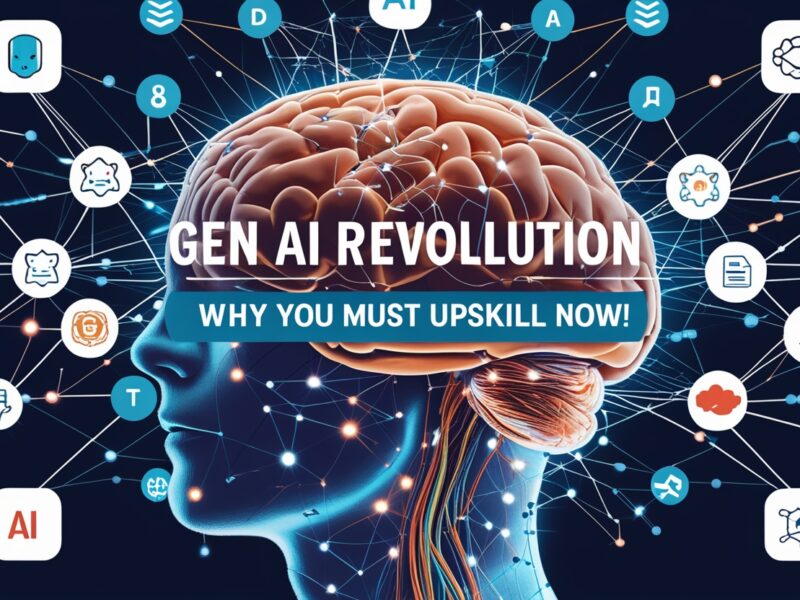The world is standing on the edge of a transformation so massive that it will redefine industries, economies, and careers. In May 2025, Microsoft shocked the corporate world by firing 7,000 employees, around 3% of its workforce. But what came next was even more surprising: an announcement to spend $80 billion in a single year on AI infrastructure, particularly on data centers. Not in five years, not spread over a decade, but within just twelve months. This is not a routine business investment it is a clear signal that the Gen AI revolution is here, and it is moving at an unprecedented pace.
The rise of generative AI and machine learning is not just another tech trend. It is, in many ways, the biggest shift of our generation. For some, it is a reason to fear. For others, it is the opportunity of a lifetime. Which side you fall on will depend entirely on one factor: whether you choose to upskill now or wait until it’s too late.
The Changing Nature of Jobs:
There is no denying that AI is disrupting jobs. Research estimates that AI could replace as many as 300 million jobs worldwide, which is roughly 9 to 10 percent of the global workforce. This reality has sparked fear in boardrooms, factories, and offices everywhere. People worry that their roles could be automated away.
However, history tells us a different story. This fear is not new it appeared during the industrial revolution, the arrival of computers, the rise of the internet, and even the launch of smartphones. Each time, jobs did disappear, but new and often better jobs emerged. AI is no different in this regard. The World Economic Forum predicts a 40% rise in demand for AI and machine learning roles between 2023 and 2027. That is not a sign of job extinction it is a signal of a skills shift.
In the United States alone, AI-related job openings could reach 1.3 million in the coming years. Yet, there are currently only about 64,000 skilled professionals ready to fill them. India faces an even larger gap, with a projected shortfall of 1 million skilled AI workers by 2027. The problem is clear: the demand is soaring, but the supply of talent is nowhere close.
AI is the New Electricity:
When Microsoft’s senior leadership compared AI to electricity, they were not exaggerating. Think back to the early 1900s when electricity revolutionized industry. It lit up factories, extended working hours, and powered machines that changed manufacturing forever. Today, AI is on track to do the same, only faster and on a much larger scale.
Administrative tasks, repetitive processes, and mundane workflows are now within AI’s reach. Instead of spending hours doing things a machine can do in seconds, humans will be freed to focus on creative, strategic, and high-value work. The result will not be fewer jobs it will be different jobs. But they will only be available to those who adapt.
The Three Types of People in a Tech Revolution:
Whenever a technological shift arrives, people tend to fall into three categories. The first are early adopters, those who see the wave coming and jump on it before it becomes mainstream. They take risks, learn quickly, and often gain the most rewards.
The second group is followers. They watch early adopters succeed, and only then decide to join in. Followers can still benefit, but their opportunities are fewer, and they often arrive late to the most lucrative openings.
The third group is the resistors, or as some call them, the “necessaries.” These individuals refuse to believe change is coming until it is unavoidable. By the time they adapt, they are forced into lower positions, scrambling to catch up in a market that has already moved forward without them.
Right now, AI is creating the next wave of early adopters. Those who act today could be the tech leaders, innovators, and highly paid specialists of tomorrow. Those who delay may end up in the follower or resistor category, with far fewer options.
Why Upskilling is Urgent:
Being an early adopter is not about having been involved in AI back in 2021 or 2022. It is about how quickly you adapt from this moment forward. Over the next five years, the people who immerse themselves in AI and machine learning will be at the forefront of a transformed economy. The rest will be trying to catch up.
Upskilling is the bridge between where you are now and where you could be in the AI-driven world. While you can try to teach yourself through trial and error, AI technology is advancing so quickly that professional training has become the fastest and most reliable route. The right course will give you structured learning, real-world projects, and industry-recognized certification all of which will make you competitive in a global talent pool.
Professional programs, especially those designed in collaboration with respected institutions and industry leaders, are one of the best ways to fast-track your readiness. They don’t just teach you how AI works, they teach you how to use it to solve real problems, making you valuable to employers from day one.
The AI Market Explosion:
If you want to understand why this is such an extraordinary opportunity, look at the numbers. In 2022, the global AI market was worth around $40 billion. By 2032, it is projected to reach $1.3 trillion, growing at an annual rate of 42%. That is faster than almost any other industry in history.
For India alone, AI is expected to contribute an additional $100 billion to GDP by 2025–26. This means that the people who are ready with the right skills will be positioned to take advantage of one of the largest economic shifts of our lifetime.
Lessons from Past Opportunities:
Every major technological revolution creates winners and losers. In 2007, Twitter launched, and a few years later, Bitcoin was quietly gaining attention in tech circles. Many people ignored it, thinking it was a fad. Had they invested just a small amount back then, the returns today would be astronomical. The lesson is simple: early adoption pays off.
The same principle applies to AI today. If you invest your time and effort into learning it now, the potential payoff in five to ten years could be life-changing. And even in the unlikely event that AI growth slows, you will still have gained skills that are valuable in countless industries. There is almost no downside.
The Window is Open For Now:
Technological waves do not wait. They sweep across industries, changing everything in their path, and then they stabilize. Once that happens, the biggest opportunities have already passed. AI is in that early, high-growth phase right now. Those who position themselves correctly will ride the wave. Those who hesitate may spend the next decade wishing they had acted sooner.
The choice is yours. You can be an early adopter, ready to take full advantage of what AI has to offer, or you can watch others lead the way while you follow behind. The future will not wait for your comfort zone.
Conclusion:
The Gen AI revolution is not a distant future it is already here, reshaping how we work, think, and create. Microsoft’s $80 billion investment is just one indicator of the scale and speed of this change. Jobs will evolve, industries will shift, and entire economies will be redefined. The only question is whether you will adapt in time.
Upskilling is no longer optional. It is the difference between being in control of your career or being controlled by circumstances. Learn the skills, get certified, and immerse yourself in AI now. History has shown that early adopters win not just because they are first, but because they prepare when others are still hesitating. In the Gen AI era, the best time to start was yesterday. The second-best time is today.
FAQs:
1. What is the Gen AI revolution?
The Gen AI revolution refers to the rapid rise of generative AI and machine learning technologies that are transforming industries, economies, and job markets. It is considered one of the biggest shifts of our generation, comparable to the introduction of electricity or the internet.
2. Will AI replace all human jobs?
No, AI will not replace all jobs. While some roles will be automated, new and often better opportunities will emerge. The real shift is in the skills required to thrive in this new economy, which is why upskilling is essential.
3. Why is upskilling in AI urgent right now?
AI technology is advancing at an unprecedented pace. Those who learn and adapt early will have access to the most lucrative roles, while latecomers may find themselves struggling to compete in a market that has already moved forward.
4. How big is the AI market expected to become?
The global AI market, valued at around $40 billion in 2022, is projected to grow to $1.3 trillion by 2032. This represents one of the fastest-growing industries in history, creating massive opportunities for skilled professionals.
5. What are the best ways to upskill in AI?
The most effective approach is to join professional AI programs developed with industry leaders and educational institutions. These provide structured learning, real-world projects, and recognized certifications, ensuring you gain both knowledge and practical application skills.

